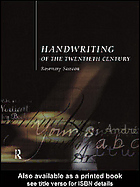
Handwriting of the twentieth century PDF
Preview Handwriting of the twentieth century
HANDWRITING OF THE TWENTIETH CENTURY Rosemary Sassoon The changing face of school books as illustrated by these two exercise books written a century apart. HANDWRITING OF THE TWENTIETH CENTURY Rosemary Sassoon London and New York First published 1999 by Routledge 11 New Fetter Lane, London EC4P 4EE This edition published in the Taylor & Francis e-Library, 2005. “To purchase your own copy of this or any of Taylor & Francis or Routledge’s collection of thousands of eBooks please go to www.eBookstore.tandf.co.uk.” Simultaneously published in the USA and Canada by Routledge 29 West 35th Street, New York, NY 10001 © 1999 Rosemary Sassoon All rights reserved. No part of this book may be reprinted or reproduced or utilised in any form or by any electronic, mechanical, or other means, now known or hereafter invented, including photocopying and recording, or in any information storage or retrieval system, without permission in writing from the publishers. British Library Cataloguing in Publication Data A catalogue record for this book is available from the British Library Library of Congress cataloguing in Publication Data A catalogue record for this book has been requested ISBN 0-203-02705-1 Master e-book ISBN ISBN 0-203-22262-8 (Adobe eReader Format) ISBN 0-415-17881-9 (hbk) ISBN 0-415-17882-7 (pbk) Contents Chapter 1 The influences on contemporary handwriting A historical 1 perspective A long and sorry story, issues to balance in handwriting, pen holds and the resulting letterforms, different teaching methods. Chapter 2 The turn of the century 16 Henry Gordon’s Handwriting and How to Teach it, Mrs Bridges’ A New Handwriting for Teachers. Chapter 3 Learning from copy books 25 Series of copybooks, Vere Foster, details from other copy books, other sources, repetition, problems and usage. Chapter 4 Simplifying letterforms 45 Edward Johnston, Graily Hewitt, steps towards print script, David Thomas and handwriting reform. Chapter 5 Initiatives and models from 1930 59 The italic handwriting revival and Alfred Fairbank, the spread of print script, and the Marion Richardson solution, the Montessori influence. vi Summing up half a century of changes in letterforms, letters for reading and letters for writing, changing attitudes to the writer and variability of handwriting. Chapter 6 Educational attitudes mid-century 80 A Handbook for Schools 1954, Primary Education 1959, Robin Tanner’s widening view of handwriting as a craft and Reginald Piggott’s survey of adult handwriting, Chapter 7 Stylistic issues after 1950 93 The arguments for and against print script, italic models, Alfred Fairbank’s contribution to Beacon Handwriting, in praise of italic, towards italic as a national model and problems of teaching italic. Chapter 8 Initiatives in the 1960s 1 08 The Nelson Handwriting scheme, Ruth Mock, Ruth Fagg and Everyday Handwriting and The Initial Teaching Alphabet. Chapter 9 From 1970 to the National Curriculum 1 19 The work of Tom Gourdie, Tom Barnard and Christopher Jarman. What was happening in the classroom and official guidance and intervention from other disciplines. The National Writing Project, emergent writing and vii bridging the gap between skill and creativity in Scotland. Chapter 10 The end of the century 1 30 The changing face of Nelson, the National Curriculum, and handwriting and the computer. A critical review of a century of the teaching of handwriting the author’s contribution to handwriting studies, and some personal conclusions. Chapter 11 Handwriting around Europe 1 43 The historical background, Mulhaüser, traditional Ronde models. French handwriting, German handwriting, handwriting from the Nordic countries, different attitudes to models, briefly around Europe and some conclusions. Chapter 12 America and Australia 1 64 The Spencerian style of penmanship, the Palmer method of cursive, the advent of manuscript, italic in the USA, the modernising effects of D’Nealian, Palmer script today and personal handwriting. Australia at the turn of the century, New South Wales, Western Australia and South Australia, Queensland and Victoria and standardising handwriting. Epilogue 1 82 References 1 83 Index 1 87 ACKNOWLEDGEMENTS I would like to thank the many people who have given advice, shared reminiscences and provided samples of their own or other people’s handwriting. The publishers and authors who have given permission for me to use their model or illustrations are all acknowledged on the pages that they appear. I would like to thank others too: Jon Tacey of Philip and Tacey and John Handforth of Macmillan for valuable information from their archives, Peter Foden and the Oxford University Press for access to their archives, Dr Elizabeth James and Christopher Skelton-Foord of the British Library and James Mosely of the St Bride Printing Library; also Alec Jackson of the National Arts Educational Archive and Professor John Swift, for information about Marion Richardson, and Philip Poole who provided so many useful copybooks. Special thanks to Nan Jay Barchowsky for all her help on US handwriting, and Kathleen Strange and Paul Green- Armytage for invaluable access to their collections. I would like to thank my husband John for his invaluable support and assistance, and my editor Helen Fairlie for her expertise, and encouragement. Most important of all I am so grateful for the help given to the whole project by Michael Blacker, not only in designing the book but also in advising and visually editing while we waded through the piles of material to produce the complex pages of illustrations. Every effort has been made to obtain permission to reproduce copyright material. If any proper acknowledgement has not been made please contact the publishers. ix A contribution by Joseph Champion to George Bickham’s compendium of the work of contemporary English writing masters, The Universal Penman, produced in 1733.
